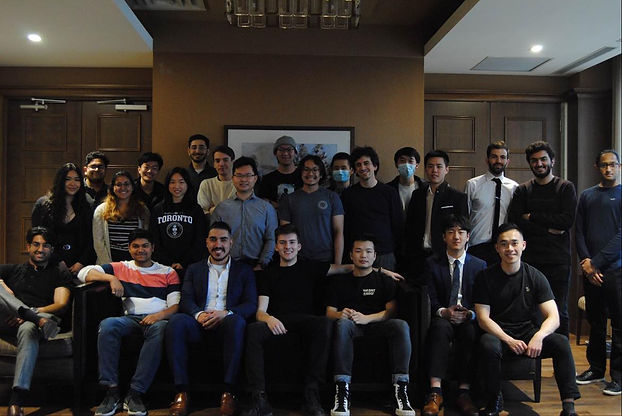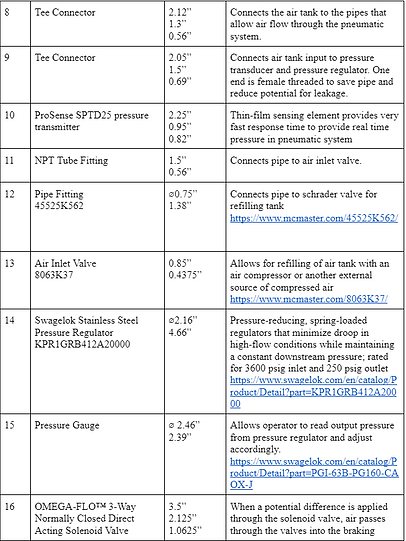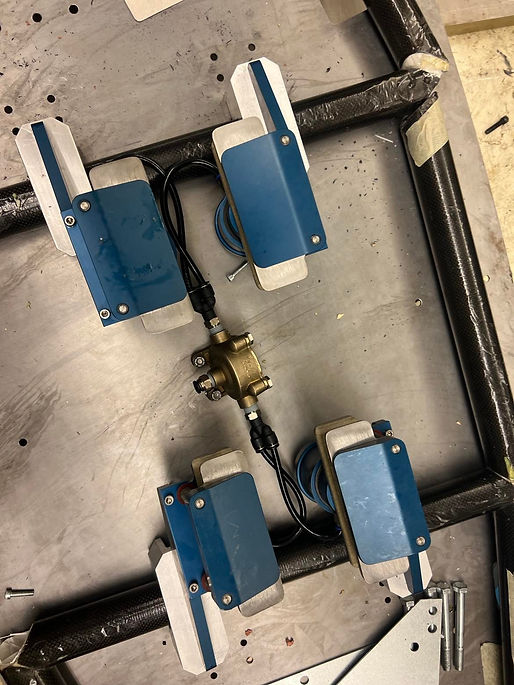Melissa Ma
Junior Mechanical Engineering Student @ University of Toronto | Engineering with a Purpose
Feel free to zoom in/out for better viewing experience of website!
Hyperloop
(Braking Team Lead)




Braking System Components





CAD of braking system

Working principles:
-
The purpose of the braking system is to slow down and stop the pod safely. The braking units clamp onto the top flanges of the I beam and the pressure is applied by an internal spring. To release the clamping force, compressed air (145psi) must be fed into the brakes to counteract the spring compression force. To supply the air, a compressor is used to fill up a 100oz tank to 1000psi. Then the pressure is stepped down with a pressure regulator to the 145 psi needed and the flow is controlled by a three-way (normally closed) solenoid valve.
-
Brakes off
When the 3-way (normally closed) solenoid valve is energized, it allows air to pass through from its cylinder port to the pressure port which allows air to pass through itself. This pressure fills the air cylinder in the braking units to push up through a spring mechanism. The braking pads are now detached from the I-beam track. -
Brakes on
When the 3-way (normally closed) solenoid valve is de-energized, it allows air to pass through from its cylinder port to the exhaust port which vents air out to the environment. This pressure differential causes the quick exhaust valve to release air at a fast rate. Connected to four pipes, the quick exhaust valve quickly vents air out of the braking units. The springs in the braking units force the braking pads to clamp onto the I-beam and the pod comes to a stop.
Preliminary assembly during Covid times, using tube cutter/deburrer and wrench
Mounting braking system onto a sheet metal, using tube cutter/bender, screw driver, and drill press

Mounting brake units and quick exhaust valve onto the bottom frame of pod; acrylic tubes had to be used instead of metal tubes because it was difficult to bend metal tubes for small turn radii. In order for this to work, I ensured that the acrylic tubes are sufficiently rated for the downstream pressure. I used a mill to manufacture the metal brake mounts.

Integrating solenoid valve with electronics (Relay requires 12V from the battery to operate. When activated, it allows 12V to get to the solenoid which activates that and in turn the brakes)

Air Tank, the gray mounts were 3D printed and the spacer are customly sawed

Air Compressor Used to Fill Air Tank

Brakes In Action!

FMEA

Hyperloop is an amazing mass transportation technology to propel the world's transition to sustainable energy. To become more involved and connect with teams worldwide, I joined the Canadian Hyperloop Conference (CHC) technical team as a mechanical engineer. In May 2022, I helped host the First Annual CHC in Waterloo, Canada.



Role
Mechanical Engineer | CAD Designer| Braking Team Leader | Technician
Project Highlights
-
Assembled the pneumatic braking system by contacting suppliers, researching about 30+ parts specs, and using drill press, milling machine, tube bender/cutter, wrench, etc.
-
Created FMEA and performed testing on the pneumatic system using an air compressor and solenoid valve (integration with electronics) to ensure that the system meets safety requirements
-
Re-designed the configuration of ten battery modules using SolidWorks, to reduce the space they take on the Hyperloop pod by 15%
-
Hosted biweekly SolidWorks workshops for team members
-
Liaised the design and manufacturing processes (integration with electronics team, made hundreds of trips to hardware stores to source parts, etc) to compete in the annual SpaceX Hyperloop Pod Competition with 20+ Universities worldwide.
-
Produced Final Design Demonstration and Whitepaper reports for Canadian Hyperloop Conference and European Hyperloop Week
-
Contacted suppliers/manufacturers to promptly obtain specs that are not listed on their websites
-
Canadian Hyperloop Conference:
-
Reviewed 3 technical whitepapers (subsystem descriptions and testing) from Canadian and International student teams, identifed safety hazards, and provided feedback to teams according to the rulebook.
Tools
SolidWorks | Rendering | Hand Calculations | Power/Hand Tools| Leadership Skills | Iterative Design
Results/Lessons Learned
-
Successfully submitted design documents and whitepapers for demonstration and showcase to European Hyperloop Week and Canadian Hyperloop Conference.
It is very important to document the supplier of every component, design choice, and problem/solution that was encountered. This makes it easier to offer potential solutions in case a problem arises in the most efficient way, and can help justify testing results. -
Being transparent about problems is key. Communicating these types of things and having others review your thought process can spark conversation and allow everyone to come up with ideas. After all, a band of sticks is stronger than one alone.
-
It's helpful to evaluate constraints. Sometimes, the constraint might be a simple assumption that can be worked around. Temporarily ignoring constraints can help us to see things from a different perspective and evaluate trade-offs.
-
Have an open mindset when tackling problems and be creative. Once, I wanted to shorten a plastic spacer for the tank mount. The spacer was very hard plastic, so I assumed that it cannot be cut with a handsaw. After trying (as per a teammate's suggestion), it actually cut right through! This experience (along with many others), taught me not to have a fixed mindset. Always try it first (as long as it's safe and doesn't cost too much time/capital) before coming to any conclusions.
-
Be transparent with the team about timelines. Do not be overly optimistic and overlook certain details. The team is a very useful resource to review any flaws and missing details in your project timeline that you should be aware of.
-
Along with these teamwork experiences, I learned a lot about different concepts such as pressure ratings and how to pick the right tube, how a pneumatic braking line works, the working principles of a solenoid/quick exhaust valve, and how to use air compressors to fill up a air tank. I also obtained a lot of valuable hands-on experience, such as using a ratchet wrench, dremel, band saws, drills, milling machines, tube cutter/bender, and many others.